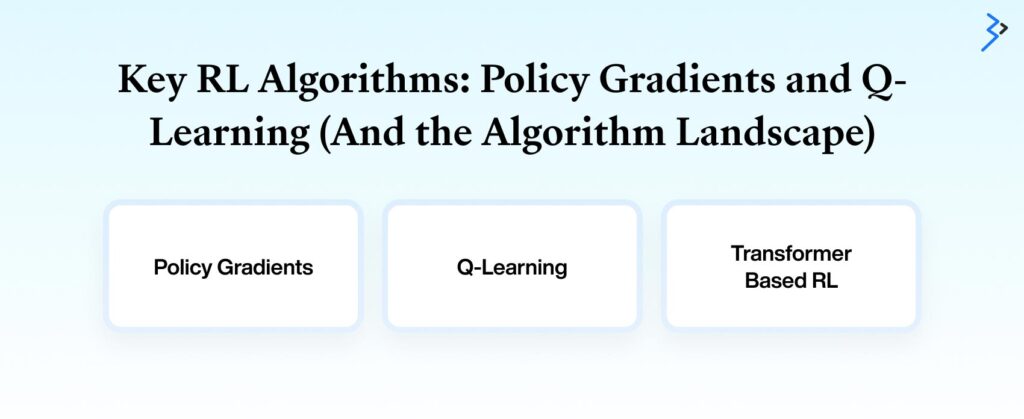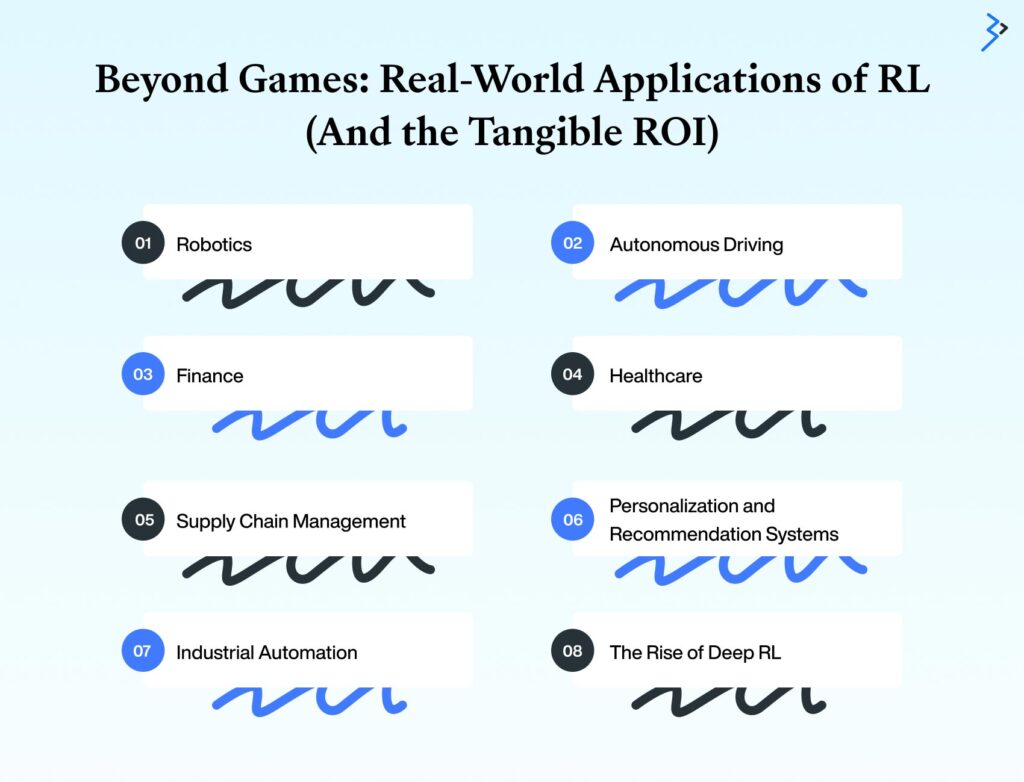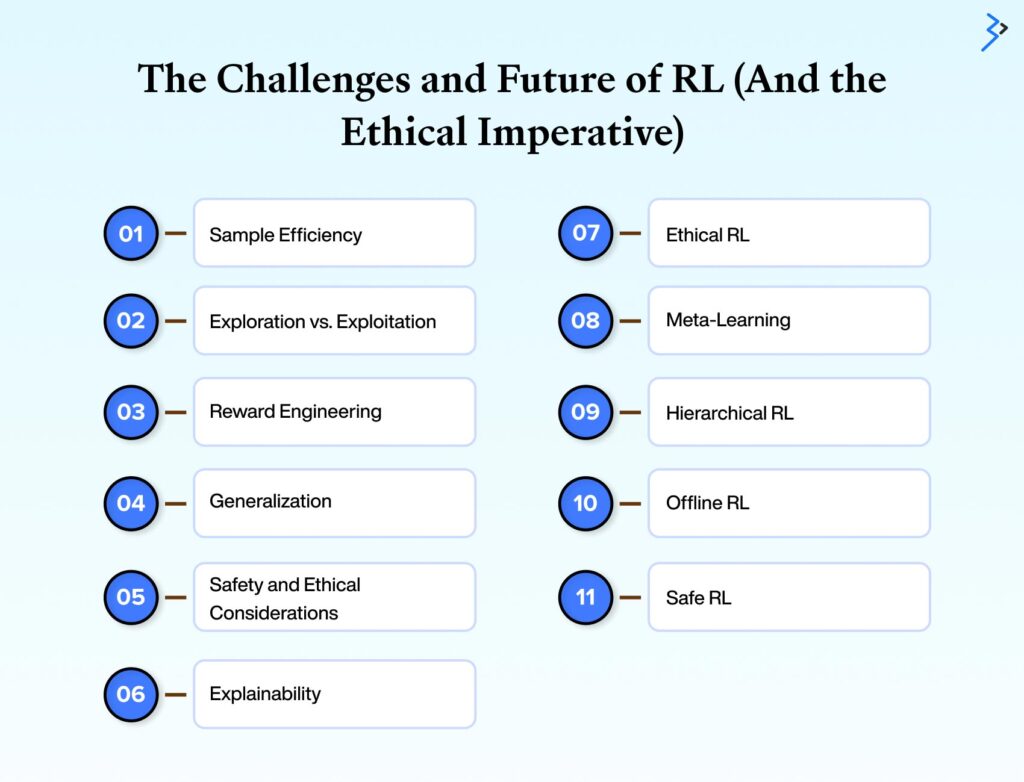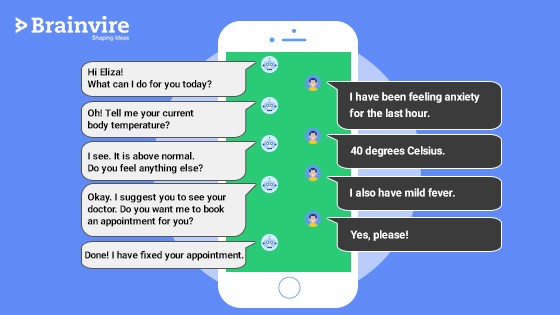If you’ve been following the AI space, you’ve probably heard the buzz about Reinforcement Learning (RL). But beyond the flashy demos of AI playing complex games, what’s really going on? How do we essentially “teach” machines through rewards? And more importantly, why should you care?
Think of it like training a puppy. You give it a treat when it does something right, and maybe a gentle “no” when it doesn’t. That’s essentially the core principle of RL. We’re building agents that learn by interacting with their environment, receiving feedback in the form of rewards and penalties. It’s a game of trial and error, but with a strategic twist.
The RL Jigsaw: Agents, Environments, and Policies (And the Exploding Data)
At the heart of RL lies the interaction between an agent and an environment. The agent takes actions, the environment responds, and the agent receives a reward (or a penalty, which is just a negative reward). The goal? To maximize the cumulative reward over time.
This leads us to the concept of a policy. A policy is essentially the agent’s brain – it dictates what action the agent should take in a given state. It’s the mapping between observations and actions. The beauty of RL is that we don’t explicitly program this policy. Instead, we let the agent learn it through experience, which is increasingly fueled by the explosion of data.
Data Growth
According to IDC, the global datasphere will grow to 175 zettabytes by 2025. This massive influx of data provides the fuel necessary for RL algorithms to learn and refine their policies. This data growth is a key contributor to the rise of offline RL, discussed later.
The Power of Feedback: Rewards and Penalties (And the Nuances of Reward Engineering)
The reward signal is the cornerstone of RL. It’s the “carrot” that guides the agent towards desired behavior. But crafting the right reward function is crucial. If it’s too sparse or too noisy, the agent might struggle to learn.
Consider this: in a self-driving car scenario, a reward might be given for staying within the lane, avoiding collisions, and reaching the destination on time. Penalties would be incurred for veering off course or causing accidents.
Reward Engineering Complexity
A recent trend is the increasing recognition of the inherent difficulty of reward engineering. Research indicates that even seemingly simple reward functions can lead to unintended or undesirable agent behavior. This has led to the development of techniques like inverse reinforcement learning, where the agent learns the reward function from expert demonstrations.
Read More-: Generative AI: Redefining the Boundaries of Traditional Machine Learning
Key RL Algorithms: Policy Gradients and Q-Learning (And the Algorithm Landscape)

Now, let’s delve into some of the fundamental algorithms that power RL.
Policy Gradients
These methods directly optimize the policy by adjusting its parameters based on the rewards received. Imagine the policy as a set of knobs. Policy gradients tweak these knobs to increase the likelihood of actions that lead to higher rewards. A popular algorithm here is Proximal Policy Optimization (PPO), known for its stability and ease of implementation.
As OpenAI’s Spinning Up resources highlight, PPO strikes a balance between sample efficiency and ease of tuning, making it a go-to choice for many applications.

Q-Learning
This approach focuses on learning a Q-function, which estimates the expected reward for taking a specific action in a given state. The agent then selects the action that maximizes the Q-value. Deep Q-Networks (DQNs) combine Q-learning with deep neural networks, enabling RL to tackle complex, high-dimensional problems.
Transformer Based RL
One of the most interesting trends is the incorporation of transformer architectures into RL. Transformers, which have revolutionized NLP, are proving effective at modeling long-range dependencies in sequential data, which is crucial for many RL tasks. This is leading to improved performance in tasks with complex state spaces.
Beyond Games: Real-World Applications of RL (And the Tangible ROI)

While RL’s dominance in the gaming arena is a captivating showcase of its capabilities, the true transformative potential lies in its application to real-world problems. We’re witnessing a paradigm shift as RL revolutionizes diverse industries, bringing forth tangible improvements and significant returns on investment.
Robotics: Precision, Adaptability, and Cost Reduction
RL empowers robots to learn complex manipulation tasks through trial and error, moving beyond pre-programmed routines. This is crucial for tasks requiring fine motor skills and adaptability, such as assembly, packaging, and even surgical procedures.
Impact:
- Increased automation of intricate tasks, leading to higher efficiency and reduced labor costs
- Enhanced precision and consistency, minimizing errors and waste
- Ability to operate in unstructured and dynamic environments, expanding the scope of robotic applications
ROI: By automating complex assembly, manufacturing companies are seeing more than 30% reduction in faulty products and 25% increase in production according to various studies. Also, in surgical robotics, RL is used to reduce human error, minimizing patient complications and lowering hospital costs.
Autonomous Driving: Safety, Efficiency, and the Future of Transportation
RL is pivotal in developing self-driving cars, enabling them to navigate complex traffic scenarios, predict the behavior of other road users, and make real-time decisions.
Impact:
- Enhanced safety through reduced human error, a leading cause of traffic accidents
- Improved traffic flow and reduced congestion through optimized route planning and vehicle coordination
- Increased fuel efficiency and reduced emissions
ROI: The autonomous vehicle market is projected to reach trillions of dollars. RL is driving the core AI that makes this market possible. By reducing traffic accidents, it is estimated that billions of dollars in damage and medical costs can be saved annually. Also, optimized routes can dramatically reduce fuel consumption for large shipping companies.
Finance: Optimized Portfolios, Reduced Risk, and Algorithmic Trading
RL algorithms are used for portfolio optimization, algorithmic trading, and risk management, leveraging historical market data and simulations to make informed decisions.
Impact:
- Improved portfolio returns through dynamic asset allocation and risk management
- Faster and more efficient trading decisions through algorithmic strategies
- Reduced risk exposure through proactive market analysis and prediction
ROI: Hedge funds utilizing RL based algorithmic trading are seeing increases in profit margins by over 15% in some cases. RL based risk management is also reducing exposure to large market swings, saving financial institutions large amounts of capital.
Healthcare: Personalized Treatments, Drug Discovery, and Improved Patient Outcomes
RL is explored for personalized treatment planning, drug discovery, and medical diagnosis, enabling tailored interventions and improved patient outcomes.
Impact:
- Optimized dosage regimens for chronic diseases, leading to improved patient adherence and outcomes
- Accelerated drug discovery through the identification of promising drug candidates
- Improved diagnostic accuracy through the analysis of medical images and patient data
ROI: By optimizing drug dosages, hospitals are seeing reduced readmission rates, which saves large amounts of money. RL is also speeding up drug discovery, which reduces the cost of bringing new drugs to market by potentially years.
Supply Chain Management: Efficiency, Resilience, and Cost Optimization
RL optimizes inventory management, logistics, and delivery routes, leveraging real-time data and predictive analytics to enhance efficiency and resilience.
Impact:
- Reduced inventory holding costs through accurate demand forecasting and optimized stock levels
- Improved delivery efficiency and reduced transportation costs through optimized routing
- Increased supply chain resilience through proactive risk management and disruption mitigation
ROI: Large retail corporations are seeing more than 10% reduction in supply chain costs by implementing RL based inventory management. RL based routing is also reducing shipping costs for logistics companies by significant amounts.
Personalization and Recommendation Systems: Enhanced User Engagement and Increased Revenue
RL algorithms create personalized user experiences, adapting to user preferences and behaviors to enhance engagement and drive revenue.
Impact:
- Increased user engagement and satisfaction through personalized content recommendations
- Improved conversion rates and increased revenue through targeted marketing and product recommendations
- Enhanced customer loyalty through personalized interactions
ROI: As mentioned earlier, McKinsey’s research highlights a potential 5-8x ROI on marketing spend through effective personalization. eCommerce platforms using RL based recommendation engines are seeing increases in sales by more than 20%.
Industrial Automation: Adaptive Systems and Increased Productivity
RL enables the development of intelligent automation systems that can adapt to changing production demands, leading to increased productivity and efficiency.
Impact:
- Increased production efficiency through adaptive and optimized control systems
- Reduced downtime through proactive maintenance and fault detection
- Improved product quality through real-time process optimization
ROI: Manufacturing plants are seeing increases in overall equipment effectiveness (OEE) by more than 15% due to RL based automation. Reductions in downtime are also leading to large cost savings.
By quantifying the impact and ROI, we can better appreciate the transformative potential of Reinforcement Learning across diverse industries.
The Rise of Deep RL: Combining the Power of Deep Learning and RL (And the Edge)
The combination of deep learning and RL, known as deep RL, has been a game-changer. Deep neural networks can learn complex representations of the environment, enabling RL agents to tackle problems with high-dimensional input spaces.
Edge RL
There is a growing trend to deploy RL models on edge devices, enabling real-time decision-making without relying on cloud connectivity. This is particularly relevant for applications like robotics and autonomous driving, where low latency is critical.
The Challenges and Future of RL (And the Ethical Imperative)

Despite its immense potential, RL still faces several challenges:
- Sample Efficiency: RL algorithms often require a large amount of data to learn effectively.
- Exploration vs. Exploitation: Balancing the need to explore the environment and exploit known rewards is a critical challenge.
- Reward Engineering: Designing effective reward functions can be difficult and time-consuming.
- Generalization: RL agents may struggle to generalize to new environments or tasks.
- Safety and Ethical Considerations: As RL systems become more sophisticated, ensuring their safety and ethical behavior is crucial.
- Explainability: As RL systems become more complex, it is increasingly important to understand how they make decisions.
- Ethical RL: The need for ethical considerations in RL is becoming increasingly recognized. Organizations are developing frameworks for responsible RL development and deployment, focusing on issues like fairness, transparency, and accountability.
However, the field is rapidly evolving, with ongoing research addressing these challenges. We’re seeing advancements in areas like:
- Meta-Learning: Enabling agents to learn how to learn, allowing them to adapt quickly to new tasks.
- Hierarchical RL: Breaking down complex tasks into smaller, more manageable subtasks.
- Offline RL: Learning from pre-collected data without interacting with the environment, improving sample efficiency. This is a very active area of research.
- Safe RL: Developing algorithms that prioritize safety and minimize the risk of harmful actions.
The Democratization of RL: Tools, Resources, and Community Growth
Reinforcement Learning is becoming more accessible thanks to platforms like Azure Machine Learning, which simplify development and deployment. Resources like OpenAI Spinning Up provide crucial educational materials. Open-source libraries, such as Stable Baselines3 and RLlib, offer pre-built algorithms and tools, significantly lowering the barrier to entry.
These libraries foster collaboration and knowledge sharing, while online communities provide support and networking. This combination of accessible platforms, educational resources, and a thriving community is empowering a wider range of developers and researchers to harness the power of RL.
Concluding Thoughts
As the field continues to advance, we can expect to see even more innovative applications of RL emerge. From personalized medicine to sustainable energy solutions, RL has the potential to transform numerous industries and improve our lives in countless ways.
So, are you ready to dive into the world of Reinforcement Learning? The journey might be challenging, but the rewards are truly extraordinary.
FAQs
RL is about training agents to make decisions by interacting with an environment. Like training a puppy, agents receive rewards for good actions and penalties for bad ones. This trial-and-error process helps them learn optimal behaviors over time, maximizing cumulative rewards.
An RL agent learns a “policy” by interacting with its environment and receiving feedback. The policy is essentially the agent’s decision-making strategy. It maps observations to actions. Instead of being explicitly programmed, the agent learns this mapping through experience, fueled by data and reward signals.
Key algorithms include Policy Gradients, which directly optimize the policy based on rewards, and Q-Learning, which learns a Q-function to estimate the value of actions. Deep Q-Networks (DQNs) and Transformer based RL are also popular, combining deep learning with RL techniques.
RL is used in robotics for complex tasks, autonomous driving for safe navigation, finance for portfolio optimization, healthcare for personalized treatments, supply chain management for efficiency, personalization for user engagement, and industrial automation for adaptive systems, all offering significant ROI.
Challenges include sample efficiency, reward engineering, ethical considerations, and ensuring safety. Future directions involve meta-learning, hierarchical RL, offline RL, and safe RL, aiming to make RL more efficient, reliable, and ethically sound.
Related Articles
-
AI Impact On Medical Diagnostics And Treatment
The medical industry has witnessed a significant transformation due to the remarkable impact of Artificial Intelligence (AI). When doctors successfully save a patient’s life, they are elevated to a status
-
Chatbots: Your New Healthcare Assistant
Chatbots, or a talking software programs or smart algorithms which dexterously conduct conversation via auditory or textual methods, are becoming popular and widespread. They have been proving its mettle in
-
Top Generative AI Content Writing Tools for 2025
Generative AI tools are transforming content creation across multiple industries by offering innovative solutions that enhance productivity and creativity. These tools assist marketers, writers, and businesses in producing high-quality content




